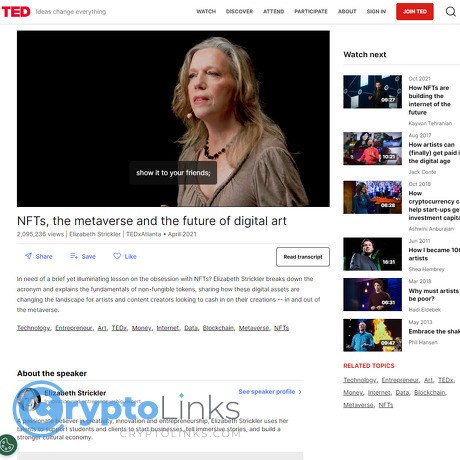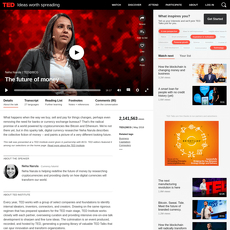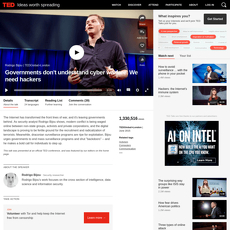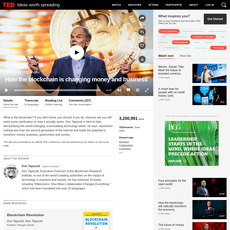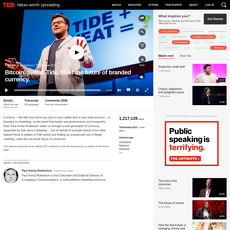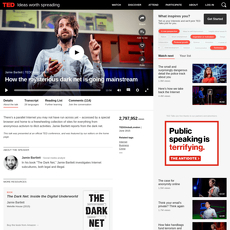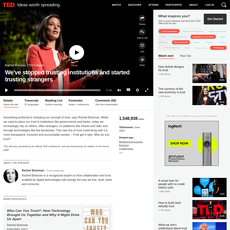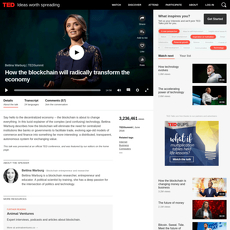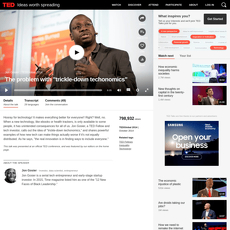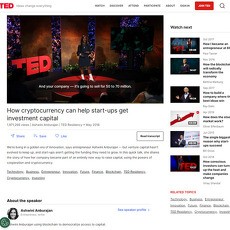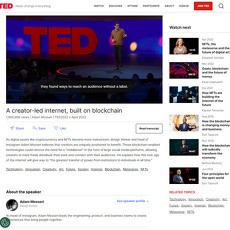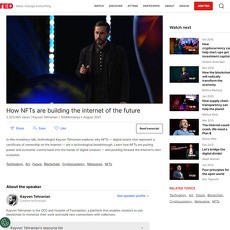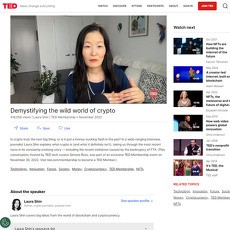Elizabeth Strickler: NFTs, the metaverse and the future of digital art Review
Elizabeth Strickler: NFTs, the metaverse and the future of digital art
www.ted.com
Elizabeth Strickler on NFTs, the Metaverse, and the Future of Digital Art: My No‑Fluff Review + FAQ
Still wondering if NFTs and the metaverse actually matter, or if it’s all smoke and mirrors? You’re not alone. I watched Elizabeth Strickler’s talk so you don’t have to chase answers across twenty tabs. In plain English, here’s what’s worth your time, what’s hype, and how to move smartly whether you make art or collect it.
This guide translates Strickler’s ideas into real takeaways: how NFTs help with provenance and community, what the metaverse means beyond gaming, and how to start safely. You’ll also get a practical FAQ based on what people actually ask.
Short version: NFTs aren’t just “JPEGs.” They’re programmable ownership records that can power memberships, royalties (with caveats), and identity in a network of virtual spaces.
Describe problems or pain
Let’s be honest—NFTs and the metaverse can feel like a maze:
- Confusing jargon: ERC-721, minting, on-chain vs off-chain… it’s a lot. Most NFTs are pointers to files, not the files themselves, which trips people up.
- Scams and fakes: Copy-mints, phishing, and fake marketplace links are common. Chainalysis flagged significant wash trading and fraud in NFT markets during the last cycle.
- Fees and volatility: Gas fees spike at peak times (live tracker), prices swing hard, and newcomers get burned rushing into mints.
- Royalties confusion: Creator earnings aren’t guaranteed across all marketplaces. Policy changes and contract settings matter, and not every platform enforces fees.
- Ownership myths: Buying an NFT usually doesn’t give you copyright. Rights must be spelled out. Storage matters too—ideally IPFS or Arweave, not just a random server (IPFS, Arweave).
- Environment worries: The old proof-of-work era left a mark. Yes, it’s much better now (Ethereum’s move to proof-of-stake cut energy use by ~99.95%—source), but people still have questions.
Artists worry about protecting their work and getting paid fairly. Collectors fear buying a knockoff or signing the wrong transaction. And lots of folks ask: how do Strickler’s ideas translate into simple, real-world steps?
Promise solution
I’ll break down the main ideas from Strickler’s talk, explain what’s real versus buzzwords, and map a safety-first path to get started. No fluff. Clear definitions. Practical tips you can use today. I’ll also answer the most common “People Also Ask” questions in one spot so you don’t have to keep Googling.
Who is Elizabeth Strickler and why listen?
Elizabeth Strickler is an educator and Web3 advocate who’s been helping creators understand how blockchain changes provenance, community, and income models. Her focus isn’t on flipping; it’s on culture: identity, access, and how artists can build durable value across platforms and virtual spaces.
What stands out is how she connects the dots: NFTs aren’t just collectibles—they’re programmable receipts that can gate content, verify membership, and travel with your digital identity across worlds. That’s bigger than a profile picture.
What you’ll learn here
- The core ideas from Strickler’s talk in simple terms
- How NFTs actually work (and what they don’t do)
- Why the metaverse matters for digital art, beyond galleries
- Safe ways to start as an artist or collector, step by step
- A practical FAQ with quick answers to real questions
If you care about creative income, provenance, and where the web is heading, this will save you hours. Ready to cut through the noise? Great—because up next I’ll unpack what Strickler actually says and how it changes your playbook. Curious what makes her take different from the usual NFT chatter?
What Strickler actually says: the big picture
Strip away the buzzwords and the headlines, and the message is simple: NFTs aren’t about flipping pictures; they’re rails for provenance, community, and programmable value. The metaverse isn’t one app—it’s the next layer of the internet where your identity, assets, and spaces connect and persist across platforms.
“In a world copy‑pasted at the speed of a click, provenance isn’t a luxury—it’s the truth that makes everything else possible.”
I’ve watched this narrative bounce between hype and backlash for years. Strickler’s take stands out because it’s grounded in what actually helps creators and the people who support them.
Key ideas from the talk
- NFTs certify origin and ownership data. The token is the public receipt that ties an asset to its creator and owner. That record stays verifiable, even if the media file lives on IPFS/Arweave or gets mirrored. Real‑world example: Art Blocks uses on‑chain generative code and provenance so collectors know exactly which series, algorithm, and artist parameters they hold.
- Creators can bake in community and revenue. An NFT isn’t just a collectible—it can be a membership pass, an access badge, or a ticket that unlocks updates and experiences. You’ve seen this with OnCyber token‑gated galleries and brand experiments like Nike .SWOOSH and Starbucks Odyssey, which use digital collectibles to reward loyal fans beyond a one‑time sale.
- Metaverse = persistent, shared digital spaces tied to identity and assets. Log in with a wallet, bring your NFTs, host an event, and keep your identity portable. Platforms like Spatial, The Sandbox, and OnCyber already let people show art, teach workshops, and run community meetups. Interoperable standards like ERC‑721 and ERC‑1155 make that portability possible.
What makes this take different
It’s not “get rich quick.” It’s “build something that lasts.” The focus is on:
- Culture and creators over traders and floor prices.
- Interoperability—ownership you can actually carry between apps, not siloed skins.
- Education—plain language and practical models instead of techno‑mysticism.
That lens lines up with what’s actually working: Reddit’s Collectible Avatars onboarded millions without the “crypto bro” vibe, and Christie's launched Christie’s 3.0 to sell art fully on‑chain because provenance is the whole game in fine art.
Big takeaways for artists, collectors, and builders
- Artists: Treat NFTs as proof of authorship and a bridge to your community. Example: editions on Zora or Manifold with token‑gated studio updates, process videos, or IRL perks. Keep the file durable (IPFS/Arweave) and tell buyers exactly what rights they have.
- Collectors: Look past price charts. Check the creator’s roadmap, cadence of updates, and how holders are treated. A small, active group beats a big, silent one. Verify the contract address and storage choices before you buy.
- Builders: UX wins. Wallet friction and clunky sign‑ins lose people. Design for the “Reddit effect”—abstract the jargon, keep the ownership under the hood, and make value obvious in seconds.
Where I agree (and where I push back)
Aligned: Provenance is the unlock; community is the moat. NFTs make it trivial to show “who made it, who owns it, and what it unlocks.” That combination is why museums care about catalog raisonnés and why digital art finally has a backbone.
Pushback: Royalties aren’t guaranteed everywhere, and that matters. Policy shifts by major marketplaces made creator fees optional in 2023, and industry analyses (see OpenSea’s creator fees update and research roundups from Galaxy Research) show enforcement varies widely. Also, UX is still rough: wallet approvals, phishing, and inconsistent “log in with wallet” flows scare newcomers. Interoperability exists in standards, but cross‑platform portability is a work in progress—the Metaverse Standards Forum is trying to align the pipes.
I’m bullish on the direction, but the details matter. So let’s zero in on the basics you’ve asked me a hundred times: what exactly is an NFT, does it actually contain the art, and what’s real about royalties? Keep going—I’ll answer those next, in plain English.
NFTs 101: clear answers to common confusion
If NFTs feel like tangled tech, you’re not alone. Here’s the clean, no-jargon version I wish someone gave me on day one.
What is an NFT in normal words?
An NFT is a unique record on a blockchain that proves who created something and who owns it now. I think of it as a public receipt with rules you can program—things like access, perks, or future splits.
- Certificate of authenticity: It’s the signed COA for digital stuff—art, music, tickets, game items.
- Public timeline: You can see the entire ownership history (provenance) on-chain.
- Programmable: It can unlock communities, content, or events via token-gating.
Real-world example: When Beeple’s “Everydays” sold at Christie’s for $69M, the NFT acted as the verifiable record of ownership, not just a fancy file. The blockchain makes that provenance public and tamper-resistant.
“An NFT is less about the pixel and more about the proof.”
Does the NFT “contain” the art?
Usually no. The token holds a pointer (a link or a content hash) to where the art lives. That file might be stored on:
- IPFS: A peer‑to‑peer network that uses content hashes (CIDs). If someone tries to swap the file, the hash breaks—so tampering is obvious. Use pinning services like nft.storage or Pinata to keep it online.
- Arweave: “Pay once, store (aimed to be) forever” model—popular for permanence. Great for long-lived art and metadata.
- Centralized servers: Fast but risky. If the server goes down or changes, your NFT can point to nothing useful.
There are exceptions. Some collections store everything on-chain (the art data is literally in the contract). Autoglyphs and Nouns are famous examples of “art-as-code” on Ethereum. It’s rare, but it exists.
Quick mental model:
- NFT = the deed.
- Art file = the house.
- Storage (IPFS/Arweave/server) = the land.
Royalties and ownership myths
This is where most people get burned—because assumptions don’t match reality.
- Royalties aren’t guaranteed by blockchains. They’re enforced by marketplaces and contracts. Some markets made creator fees optional in 2022–2024, which reduced realized royalties for many collections. Always check a marketplace’s policy and your contract settings.
- Buying an NFT doesn’t grant copyright by default. You’re buying a token and whatever license the creator attached. Read the collection’s terms.
Common license types you’ll actually see:
- All rights reserved: Personal display only, no commercial use.
- Commercial license (limited): You can monetize up to a cap (e.g., revenue limits).
- Full commercial: You can use it in merch, media, etc., with few restrictions.
- CC0: No rights reserved—anyone can remix and use it (e.g., Nouns, Moonbirds switched to CC0 in 2022).
Two-minute checklist before you buy or mint:
- Find the official contract address (from the creator’s verified site or socials).
- Read the license—don’t assume any rights.
- Confirm where the metadata and artwork are stored (IPFS/Arweave beats a random server).
- Look at marketplace royalty settings and recent sales to see if creator fees are actually paid out.
Environmental impact today
The energy story has changed a lot. Ethereum’s move to Proof‑of‑Stake in 2022 cut chain energy use by an estimated ~99.95% (Ethereum Foundation). Popular NFT ecosystems like Polygon, Solana, and Tezos also run on energy‑light consensus.
- Choose PoS chains: Ethereum, Polygon, Solana, Tezos.
- Prefer efficient storage: IPFS with reliable pinning and/or Arweave for permanence.
- Batch and plan mints: Mint during low network activity to reduce fees and waste.
If you’ve heard “NFTs are boiling the oceans,” that was largely tied to the old Proof‑of‑Work era on Ethereum. The landscape is different now, and you can make greener choices with your chain and storage stack.
So here’s the real question: once your wallet proves who you are and what you own, what happens when that identity and those assets can move with you across virtual spaces? That’s where things get exciting—let’s step into that world next.
Metaverse without buzzwords: why it matters for art
Forget the sci‑fi ad speak. The metaverse is simply a growing network of digital spaces that recognize you (your wallet, avatar, and reputation) and the things you own (your NFTs, wearables, memberships). When that clicks, digital art stops being a lonely JPEG and turns into something social, programmable, and alive.
“The future is already here — it’s just not evenly distributed.” — William Gibson
What is the metaverse really?
Think of it as persistent, shared, sometimes 3D experiences where your wallet acts like your login and inventory. Multiple worlds, not one company:
- Walk through a browser‑based gallery that reads your wallet and auto‑hangs your pieces — try Oncyber or Spatial.
- Use a portable avatar across apps — Ready Player Me works in thousands of experiences.
- Sign in with your wallet (not a password) using open standards like Sign‑In with Ethereum (EIP‑4361).
It’s less “VR headset forever” and more “your identity and assets work wherever you show up.”
Why artists and collectors should care
Because art in these spaces isn’t just displayed — it’s experienced, traded, and used as a social signal and a ticket to community. A few real‑world examples:
- Exhibitions that anyone can attend: Sotheby’s opened a virtual venue in Decentraland, extending curation into a 24/7 world you can visit from a browser. See Sotheby’s Metaverse.
- Token‑gated rooms and releases: Creators use galleries like Oncyber to unlock private salons, works‑in‑progress, or performance nights for holders only.
- Dynamic and generative art: Platforms such as Art Blocks and Async Art let pieces change over time, react to data, or shift based on owner actions — something a physical frame can’t do.
- Brand x artist collabs: Nike’s .SWOOSH and RTFKT helped normalize collectible digital wearables (on Polygon), generating millions in sales and onboarding mainstream fans into wallet‑based culture.
- Proof of taste and provenance on display: Wallet‑aware galleries let collectors show a verified timeline of what they own, where it came from, and why it matters — no more guessing which listing is fake.
Studies point to real momentum: McKinsey estimates the metaverse could create up to $5 trillion in value by 2030. Meanwhile, Reddit proved that wallet‑based collectibles can scale, with millions of Polygon avatars minted by everyday users — no crypto jargon required.
Interoperability, identity, and provenance
This is the trio that makes the metaverse useful instead of gimmicky.
- Identity: Your wallet is your portable reputation. Human‑readable names like ENS make it friendly. You can sign into apps with EIP‑4361 and carry your memberships anywhere.
- Assets: NFTs are recognized across apps thanks to shared standards like ERC‑721 and ERC‑1155. For creator payouts, ERC‑2981 describes royalty info (marketplaces still decide enforcement).
- Provenance: Because ownership and origin are on‑chain, you can verify the authentic contract address and historical transfers in seconds — essential for curators and serious collectors.
- Composability: Newer ideas like ERC‑6551 let NFTs act like accounts, so a character (or artwork) can own its own inventory — think costumes, scenes, or performance states attached to a single on‑chain identity.
Outside crypto, the Metaverse Standards Forum and open 3D formats like glTF aim to make assets portable across engines. It’s not perfect yet, but the direction is clear: less walled gardens, more shared rails.
Are we early? Signals that matter
- Standards are stabilizing: NFTs (ERC‑721, 1155), royalty metadata (2981), wallet sign‑in (4361), and smart‑account UX (4337) are moving from theory to production.
- Costs are dropping: Layer‑2 networks like Polygon, Arbitrum, Optimism, and Base make minting and interacting cheap enough for mainstream users.
- Wallet UX is getting human: Passkeys, gasless actions, and session keys (powered by account abstraction) reduce scary pop‑ups. You’ll feel this in new “one‑tap” experiences.
- Brands keep showing up: From Starbucks Odyssey to Christie’s 3.0, experiments didn’t vanish with the last hype cycle — they leveled up into loyalty and culture plays.
For artists, that means new distribution and patronage models that aren’t tied to a single app. For collectors, it means your taste can be seen and verified across worlds — not just inside one marketplace tab.
Ready to make your wallet that “passport” and avoid the classic mistakes? In the next section I’ll show the exact setup — which wallets to trust, how to split “minting” vs “vault” accounts, and simple checks that save you from scams. Want the step‑by‑step?
Getting started safely: wallets, chains, marketplaces
If you’re about to mint, buy, or list your first NFT, this is the part that saves you money and headaches. I’ll keep it hands-on, opinionated, and safety-first—because one wrong click can cost more than the art itself.
“Slow is smooth, and smooth is fast.” In Web3, moving carefully isn’t paranoia—it’s profit protection.
What wallet do I need?
Your wallet is your identity, bank account, and gallery in one. Treat it like a vault, not a casual app. Here’s the setup I use and recommend:
- Hardware (vault): Ledger (ledger.com) or Trezor (trezor.io) for long-term storage. Keep the seed phrase offline (paper or steel). Consider a passphrase/25th word and store separately. Never upload it to cloud notes.
- Software (hot/burner):
- Smart vault (teams/high-value): Safe multisig (safe.global). Great for DAOs, studios, or serious collections.
The 3‑wallet system (simple and effective)
- Burner: Fresh wallet for mints and unknown sites. Keep tiny balances only.
- Hot: Trusted marketplaces and daily activity.
- Vault: Hardware or multisig. Receive only; never connect to random sites.
5‑minute setup checklist
- Write seed phrases by hand; verify you can restore from them. No screenshots.
- Enable wallet simulation/anti-phishing: Wallet Guard (walletguard.app), Pocket Universe (pocketuniverse.app), or use wallets with built-in simulation like Rabby and Phantom (Blowfish).
- Turn off blind signing on hardware. Only toggle it on for reputable mints that require it—and back off if details look weird.
- Use a unique email and a password manager for marketplace logins with 2FA (authenticator app, not SMS).
Which blockchain should I pick?
Match the chain to your budget, audience, and tools. I think about it like venue selection for a show—you choose where your collectors already hang out.
- Ethereum (L1): Deepest collector liquidity and tooling. Best for high-end art and provenance. Fees can bite during busy hours. Popular markets/tools: OpenSea, Zora, Foundation, SuperRare, Manifold (manifold.xyz).
- Layer 2s (Base, Arbitrum, Optimism, Polygon PoS, zkSync): Same Ethereum ecosystem with much lower fees. Great for open editions, experiments, and community drops. Markets: Zora on Base, OpenSea on Polygon, and more.
- Polygon: Low-cost and brand-friendly; many mainstream collaborations have used it. Good for larger editions and social-focused releases.
- Solana: Fast, cheap, and social. Strong culture around generative collections and trading. Markets: Magic Eden, Tensor. Tooling standard: Metaplex.
- Bitcoin Ordinals: On-chain inscriptions appeal to purists and collectors who value permanence. Fees can spike and tooling is still maturing. Markets: Magic Eden (BTC), Ordinals Wallet. Wallets: Xverse, Unisat.
How I choose quickly
- Audience: Where do your buyers already collect?
- Cost: Testing or large editions? Use L2s or Solana.
- Tooling: Need no-code minting? Check Manifold (EVM) or Metaplex (Solana).
- Royalties: Understand they’re not guaranteed on every marketplace. Plan perks or token-gated utility to encourage honoring royalties.
How to avoid scams and rug pulls
I can’t stress this enough: scams are the number one “fee” most beginners pay. In 2023, wallet drainer phishing campaigns stole roughly $295M across ~324,000 victims, according to ScamSniffer. Here’s how to stay out of that stat:
- Verify contracts and links: Only click from the creator’s official domain or a pinned social post. Check contract addresses on Etherscan, Polygonscan, Solscan, or mempool.space (BTC).
- Use transaction simulation: If the pop-up shows “SetApprovalForAll” to a random contract, back out. Tools: Rabby, Phantom, Wallet Guard, Pocket Universe.
- Revoke risky permissions: Check regularly with revoke.cash (EVM). On Solana, audit “Connected apps” in your wallet and remove anything you don’t trust.
- Airdrop rule: Don’t interact with random airdropped NFTs or tokens. Many are bait to sign malicious approvals.
- Blind signing: Keep it off. If a mint requires it, the site should explain why, and the community should vouch for it. When in doubt, don’t sign.
- Test small first: Send a tiny amount, mint one edition, or list a low-value NFT to confirm behavior before you scale up.
- Team and roadmap sanity: If a “brand-new” project promises guaranteed returns, reveals celebrity partners, and mints in 15 minutes—walk away. Real creators show process, not just hype.
Costs, gas fees, and timing tips
Fees are a feature, not a bug—you’re paying for blockspace. But you can be smart about it.
- Know your fee: On Ethereum, gas = gas units × gwei price. A typical ERC-721 mint might use ~150k–220k gas. At 20 gwei and 150k gas, that’s ~0.003 ETH. Check live rates with Etherscan Gas Tracker.
- Pick your window: Fees are often lower on weekends and off-peak (roughly 01:00–05:00 UTC). No guarantees, but it helps.
- Use L2s when you can: Base, Arbitrum, Optimism, and Polygon often cost cents. Great for open editions and experimentation.
- Bitcoin Ordinals tips: Check mempool.space and choose a fee tier that won’t leave you stuck for hours. When blocks are congested, costs jump fast.
- Solana fees: Usually fractions of a cent. Keep a small SOL buffer for priority fees during hot mints.
- Marketplace fees: Expect ~0–2.5% on secondary sales depending on the venue. Creator royalties (0–10%) are often optional on the buyer side—plan holder perks to encourage honoring them.
- Bridging: Prefer official or well-known bridges (Base Bridge, Polygon Bridge, Hop, Across). Triple-check the URL; tons of bridge phishing sites exist.
- Creator splits: If you’re collaborating, use contracts with automated splits (Manifold, Zora, or 0xSplits) so nobody needs to “settle up later.”
One more emotional nudge: Your future self will thank you for being boring about security. It’s not sexy, but neither is waking up to an empty vault.
Want quick, straight answers to the questions everyone keeps Googling—like “Are NFTs dead?” “Can I lose my NFT?” and “How do I verify it’s legit?” Keep reading; I’ve got a rapid-fire section up next that cuts through the noise.
FAQ: real questions people ask (and straight answers)
Are NFTs still a thing, or is the bubble over?
Short answer: the speculation cooled off, the utility stuck around. I keep seeing NFTs used as receipts for provenance, membership passes, and on-chain identity across art platforms and brand programs. A few signals that matter:
- Reddit Collectible Avatars minted in the millions, onboarding non-crypto users without jargon.
- Nike .SWOOSH keeps experimenting with digital collectibles tied to co-creation and perks.
- Ticketing pilots add NFTs as souvenirs or loyalty layers after concerts and sports events.
Think of it like the early web: the hype waves pass, but the rails (wallets, standards, storage) keep getting better. If you care about provenance and programmable ownership, NFTs aren’t going anywhere.
Are NFTs bad for the environment?
On Proof‑of‑Stake chains, the environmental profile is dramatically better. After Ethereum’s Merge, network energy use dropped by roughly 99%+ (that’s from Ethereum Foundation analyses). Polygon, Solana, and other PoS chains run efficiently compared to the old Proof‑of‑Work model.
If you’re eco‑minded, here’s a practical setup:
- Mint on PoS chains like Ethereum (post‑Merge), Polygon, or Solana.
- Store files on IPFS or Arweave to avoid fragile centralized links.
- Batch actions and use Layer 2s to reduce on-chain overhead per asset.
Impact isn’t zero, but it’s now closer to everyday web activity than the headlines from 2021 suggest.
How do artists actually make money with NFTs?
I’ve watched creators use a mix of simple and smart plays:
- Primary sales: one‑of‑ones or editions. Example: artists release open editions for 24–72 hours to build a collector base at low cost.
- Secondary royalties: only when supported by the marketplace/contract (EIP‑2981 helps, but enforcement varies). Treat royalties as a bonus, not a guarantee.
- Token‑gated perks: holders get process videos, private chats, early drops, or live critique sessions.
- Dynamic art: pieces that evolve based on time, data, or holder actions—great for ongoing engagement.
- Brand and community collabs: limited runs with platforms, galleries, or DAOs that bring distribution.
Pattern that works: start with accessible editions, reward early holders, then scale to higher‑tier art with clear utility and consistent updates.
Can I lose my NFT?
Yes—and it usually happens from malicious approvals, phishing links, or losing your seed phrase. A few habits cut most risk:
- Use a hardware wallet for storing valuable NFTs.
- Separate wallets: a “vault” for storage and a “burner” for minting/experiments.
- Revoke token approvals regularly using trusted tools and check your connected apps.
- Never expose your seed phrase; write it down offline and test recovery before you fund heavily.
- Blind signing = bad. If your wallet can show readable messages, enable it.
If something feels off (urgent DMs, surprise airdrops), don’t connect or sign.
What’s the difference between the metaverse and Web3?
Metaverse = the experience layer: persistent, shared virtual spaces (think galleries, events, showrooms) where your items and avatar appear.
Web3 = the ownership layer: blockchains, wallets, and tokens that let you carry identity and assets between apps.
They overlap when your wallet proves access inside virtual spaces and your NFTs show up as portable items or memberships.
How do I verify an NFT is legit?
I use a quick 5‑step check:
- Find official links from the artist’s verified social or site. Don’t search marketplaces directly.
- Confirm the contract address on a block explorer (e.g., Etherscan). Copy/paste matters—look for verified contracts.
- Check creator wallet: does the mint originate from the artist’s known address or a trusted deployer?
- Inspect storage: IPFS/Arweave links and content hashes beat plain HTTP URLs on random servers.
- Provenance trail: review prior sales and transfers; brand‑new “lookalike” collections are a red flag.
Extra tip: marketplace badges help, but never rely on a blue check alone—imitations are common.
Is the metaverse just gaming?
No. It’s broader than gameplay. I’ve seen:
- Virtual exhibitions in places like Oncyber and Spatial, where your wallet populates the gallery.
- Token‑gated meetups and performances—holders prove access with their NFT.
- Education and workshops where certificates are on-chain credentials.
- Commerce: previews of physical art framed by digital ownership, and loyalty tied to wallets.
Gaming is a huge on‑ramp, but art, identity, and community spaces are growing fast.
What about regulation and risk?
Expect evolving rules around securities, IP, and consumer protection. The EU’s MiCA is rolling out crypto frameworks; the U.S. continues case‑by‑case enforcement. Practical takeaways:
- Be clear about rights included with your NFT (personal display vs commercial). Put it in the metadata or collection page.
- Keep records: mint txns, sales, and royalty receipts for tax season.
- Assume volatility and liquidity risk; never rely on future royalties to pay today’s bills.
When in doubt, get professional advice—especially for drops that promise revenue shares or “investment‑like” returns.
What will NFTs look like in 5 years?
Here’s where the road points, based on what I’m seeing in the trenches:
- Utility‑first NFTs: access, membership, and loyalty that actually do something across apps.
- Interoperability: standards like EIP‑2981 (royalties), ERC‑6551 (token‑bound accounts), and ERC‑4337 (account abstraction) make NFTs smarter and easier to use.
- Dynamic and data‑aware art: pieces that update with real‑world data or co‑creation from holders.
- Seamless UX: email or social logins tied to non‑custodial wallets under the hood, so mainstream users don’t bounce.
“In five years, the best NFTs won’t shout ‘NFT’—they’ll just be the key that unlocks the experiences you care about.”
Want a simple plan to put all this to work without getting wrecked by fees or fakes? I’ll show you exactly how I set up wallets, choose chains, and verify drops—step‑by‑step—in the next part. Which piece do you want first: security setup or a low‑cost mint strategy?
Turn ideas into action: my simple plan
3 steps for artists
- Lock in a wallet workflow you can actually manage
- Use a hardware wallet (Ledger or Trezor) for storage and a separate “burner” wallet for mints and experiments. It’s a simple split that prevents most disasters.
- Write your seed phrase on paper (twice), store it offline in two places. No screenshots. No cloud.
- Set a recurring reminder to review approvals with revoke.cash.
- Start small with a clear concept and community plan
- Launch a tight series (e.g., 25–100 editions) on a chain with fees you’re comfortable with. Polygon and Solana are friendly for entry-level costs; Ethereum has the most collectors.
- Make the why obvious: is it pure art, membership, or access? Photographers like Justin Aversano built lasting communities by pairing art with real-world moments and consistent updates. You can do the same at your scale—weekly studio notes, behind-the-scenes, or token-gated livestreams.
- Promise less, deliver more. If you plan perks, write what you’ll do in the next 90 days, not a vague “roadmap.”
- Nail storage and rights so buyers trust you
- Store files and metadata on IPFS or Arweave. Tools like NFT.Storage or Pinata make it straightforward. Keep your IPFS CIDs handy for transparency.
- Be explicit about usage rights in your metadata and description. If it’s personal-use only, say it. If it’s CC0 like Nouns, say that too.
- Test your mint with a friend before going public. Broken metadata kills trust fast.
Simple rule: protect your keys, underpromise on utility, overdeliver on presence.
Collector checklist
- Verify before you buy: check the contract on Etherscan (or the relevant scanner), match the contract address from the artist’s official site/X profile, and scan provenance. Beware near-identical collection names.
- Inspect the creator, not just the floor: look for consistent posts, a track record of delivering on small promises, and real community replies (not just retweets).
- Budget like an adult: treat NFTs as high volatility. I cap art mints to a fixed monthly amount and assume it can go to zero. If that’s not okay, skip the mint.
- Use the right wallet setup: hardware wallet for storage, burner for mints, and a separate “market” wallet for day-to-day listing and bidding. That single tweak will save you from 90% of scam vectors.
- Check storage and rights: confirm the art is on IPFS/Arweave and that the license matches your expectations. If you want commercial rights, look for collections that clearly grant them.
For brands and educators (optional but useful)
- Run a low-stakes pilot with clear benefits
- Token-gate access or perks using tokenproof, Collab.Land, or Guild.xyz. Offer something tangible: early product access, classroom materials, or VIP Q&A.
- Keep mint price near frictionless (free or a few dollars) and anchor value to ongoing utility, not speculation.
- Measure what matters
- Track retention and participation, not just mint count: weekly active holders, repeat attendance, redemption rates, and NPS.
- Case signals: Reddit Collectible Avatars passed tens of millions of mints on Polygon with strong wallet onboarding (see community dashboards on Dune). The lesson: low friction + clear identity utility beats hype-only drops.
- Stay compliant and user-friendly
- Use PoS chains (Ethereum, Polygon) to avoid environmental blowback; the Ethereum Foundation reports an ~99.95% energy reduction post-Merge.
- Speak plainly about rights and refunds. Put support instructions in the mint page, and test the flow with non-crypto users before launch.
Final take: is Strickler’s talk worth your time?
Yes. It’s grounded, creative, and focused on what actually helps—provenance, portable identity, and communities that outlast hype. If you want to create or collect with less chaos, start small, secure your setup, store your files right, and be clear about rights and value. That’s the path that keeps working, regardless of market noise.
If you try any of the steps above, keep notes on what felt smooth vs. what broke. Iterate fast, stay skeptical of shortcuts, and aim for trust over trends. That’s where the real wins stack up.

